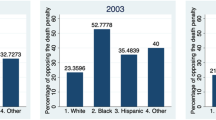Abstract
From 1940 to the present, the on-the-record consensus among Supreme Court justices fell precipitously relative to historical benchmarks. This paper first shows that Court consensus is closely associated with measures of consistency and stability of Court rulings. Then, an empirical model of Supreme Court consensus and dissension is estimated over 1800–2001 in which characteristics of the presidential–senatorial screen are key variables. Using OLS and controlling for several other influences, the results show that variations in consensus are linked to two components of the selection screen – the party of the confirming Senate and split party nominations and confirmations. Other than the selection screen, the size of the federal judiciary and consensus norms in the recent past are important influences. These results are also confirmed using GARCH and regime-shifting econometric methods.
Similar content being viewed by others
References
Bai, J., & Perron, P. (1998). Estimating and testing linear models with multiple structural changes. Econometrica, 66, 47–78.
Baird, D. G., Gerner, R., & Picker, R. C. (1995). Game theory and the law. Cambridge: Harvard University Press.
Barro, R. J. (1997). Determinants of economic growth: A cross-country empirical study. Cambridge, MA: MIT Press.
Baum, L. (1992). Membership change and collective voting change in the U.S. Supreme Court. Journal of Politics, 54, 3–24.
Baum, L. (1997). The puzzle of judicial behavior. Ann Arbor: University of Michigan Press.
Baum, L. (1988). Measuring policy change in the U.S. Supreme Court. American Political Science Review, 82, 905–914
Caldiera, G., & Zorn, C. J. W. (1998). Of time and consensual norms in the Supreme Court. American Journal of Political Science, 42, 874–902.
Clayton, C., & Gillman, H. (Eds.). (1998). Supreme Court decision making: New institutionalist approaches. Chicago: University of Chicago Press.
De Figueiredo, J. M., & Tiller, E. H. (1996). Congressional control of the courts. Journal of Law and Economics, 39, 435–462.
Easterbrook, F. H. (1982). Ways of criticizing the court. Harvard Law Review, 95, 802–832.
Engle, R. F., & Smith, A. D. (1993). Stochastic permanent breaks. Review of Economics and Statistics, 81, 553–574.
Epstein, L. (2001). The norm of consensus on the U.S. Supreme Court. American Journal of Political Science, 45, 362–378.
Epstein, L., & Knight, J. (1998). Choices judges make. Washington, D.C.: Congressional Quarterly Press.
Epstein, L., Hoekstra, V., Segal, J. A., & Spaeth, H. J. (1998). Do political preferences change? A longitudinal study of U.S. Supreme Court justices. Journal of Politics, 60, 801–818.
Epstein, L., Segal, J. A., Spaeth, H. J., & Walker, T. G. (2003). The Supreme Court compendium: Data, decisions, and developments. Washington, D.C.: Congressional Quarterly Press.
Eskridge, W. N., Jr. (1991). Overriding Supreme Court statutory interpretation decisions. Yale Law Journal, 101, 331–455.
Ferejohn, J. A., & Weingast, B. R. (1992a). Limitation of statutes: strategic statutory interpretation. Georgetown Law Journal, 80, 565–582.
Ferejohn, J. A., & Weingast, B. R. (1992b). A positive theory of statutory interpretation. International Review of Law and Economics, 12, 263–279.
Gely, R., & Spiller, P. T. (1992). The political economy of Supreme Court constitutional decisions: The case of Roosevelt’s Court-packing plan. International Review of Law and Economics, 12, 45–67.
Hamilton, J. (1994). Time series analysis. Princeton, NJ: Princeton University Press.
Haynie, S. L. (1992). Leadership and consensus on the U.S. Supreme Court. Journal of Politics, 54, 1158–1169.
Hendry, D. F., & Clements, M. (1996). Intercept corrections and structural breaks. Journal of Applied Econometrics, 11, 75–94.
Landes, W., & Posner, R. (1975). The independent judiciary in an interest group perspective. Journal of Law and Economics, 18, 875–901.
McCubbins, M., Noll, R. G., & Weingast, B. R. (1995). Politics and the courts: a positive theory of judicial doctrine and the rule of law. Southern California Law Review, 68, 1631–1683.
Nelson, D. (1991). Conditional heteroskedasticity in asset returns: A new approach. Econometrica, 59, 347–370.
Posner, R. A. (1996). The federal courts: Challenge and reform. Cambridge, MA: Harvard University Press.
Rohde, D., & Spaeth, H. J. (1976). Supreme Court decision making. San Francisco: W.H. Freeman.
Rowland, C. K., & Todd, B. J. (1991). Where you stand depends on who sits: Platform promises and judicial gatekeeping in the federal district courts. Journal of Politics, 53,171–185.
Scott, E. H. (Ed.). (1893). Journal of the constitutional convention, kept by James Madison. Chicago: Scott, Foresman, and Company.
Segal, J. A., & Spaeth, H. J. (1996). The influence of stare decisis on the votes of U.S. Supreme Court justices. American Journal of Political Science, 40, 971–1003.
Segal, J. A., & Spaeth, H. J. (1993). The Supreme Court and the attitudinal model. New York: Cambridge University Press.
Segal, J. A., & Cover, A. D. (1989). Ideological values and the votes of U.S. Supreme Court justices. American Political Science Review, 83, 557–566.
Spiller, P. T., & Spitzer, M. (1992). Judicial choice of legal doctrines. Journal of Law, Economics, and Organization, 8, 8–46.
Tate, C. N., & Handberg, R. (1991). Time binding and theory building in personal attribute models of Supreme Court voting behavior, 1916–1988. American Journal of Political Science, 35, 460–480.
Toma, E. (1991). Congressional influence and the Supreme Court: The budget as a signaling device. Journal of Legal Studies, 20, 131–146.
Wahlbeck, P., Spriggs, J., & Maltzman, F. (1998, January). Marshalling the Court: Bargaining and accommodation on the U.S. Supreme Court. American Journal of Political Science, 42, 294–315.
Walker, T., Epstein, L., & Dixon, W. J. (1988). On the mysterious demise of consensual norms in the United States Supreme Court. Journal of Politics, 50, 361–389.
Author information
Authors and Affiliations
Corresponding author
Rights and permissions
About this article
Cite this article
Goff, B. Supreme Court consensus and dissent: Estimating the role of the selection screen. Public Choice 127, 367–383 (2006). https://doi.org/10.1007/s11127-006-8290-2
Accepted:
Published:
Issue Date:
DOI: https://doi.org/10.1007/s11127-006-8290-2




